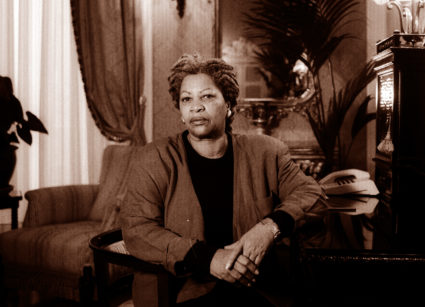
Go beyond Toni Morrison with these 7 books that stare down the white gaze
In her work and position as one of the leading literary voices in the world, Toni Morrison has helped smash the cultural assumption that the reader is, by default, white.
In the new documentary "Toni Morrison: The Pieces I Am," the Nobel laureate talks about how she felt the authors' self-consciousness while reading the works of Ralph Ellison and Frederick Douglass, black writers who worked within a framework of an assumed white audience. Morrison illustrates her point by asking a simple question of Ellison's "Invisible Man": "Invisible to whom?"
"The little white man that sits on your shoulder and checks out everything you do or say. You sort of knock him off and you're free," said Morrison, who is seen flicking the imaginary figure from her left shoulder in the documentary. "Now, I own the world. I can write about anything, to anyone, for anyone."
A recent documentary about author Toni Morrison brings the renowned writer's words to screen, while sharing an intimate personal look at her life and legacy through the eyes of a close friend. The PBS NewsHour's John Yang sits down with director Timothy Greenfield-Sanders, who has known Morrison for 38 years, to discuss how they met.
Dana Williams, president of the Toni Morrison Society and interim dean of the Howard University Graduate School, said there was a model for this artistic mentality before Morrison. African writers in the 1960s, such as Chinua Achebe, Wole Soyinka, Bessie Head and Ngugi wa Thiongo, wrote their stories on their own terms, without needing to explain them or define them in contrast to someone else's perspective.
African writers seemed to have the freedom to write these narratives, despite the intrusion of Western colonialism, Williams said.
Comparatively, during the Black Arts Movement in the U.S. in 1960s through the 1970s, "black writers largely wrote black texts for black audiences, but were always thinking about it in the context of race and white people reading," Williams said.
After the height of the Black Arts Movement, Morrison took it a step further, Williams said. During Morrison's editorship at Random House in the 1970s, she lifted many black voices within the publishing world. In this role, Morrison adopted the aesthetic of the Black Arts Movement, but also banished the limitations of the "white gaze," Williams said.
Among the authors who have expanded on Morrison's mission, Williams offers a list of seven you should read now. In Williams' words:
"The Coming" by Daniel Black
Daniel Black's "The Coming" is the first novel of the Middle Passage that is told exclusively from the perspective of those who were captured for enslavement. It casts off the white gaze and the tendency of the master narrative to tell the story with a single narrator and a single genre. "The Coming" assumes a collective narrator and is multigeneric. It's a beautifully human telling of one of the world's greatest horrors.

"Gorilla, My Love" by Toni Cade Bambara
Toni Cade Bambara's "Gorilla, My Love" is one of the smartest short story collections I've ever read. Each story puts the reader in the community from which Bambara rights — some times southern but most times urban north and always black. Most stories are told by a young girl narrator who reads culture better than the adults and society she often times finds herself critiquing.
"Half a Yellow Sun" by Chimamanda Ngozi Adichie
Chimamanda Ngozi Adichie's "Half a Yellow Sun" is a novel all about ethnic conflict brought on by war and colonialism. Yet the story isn't about "race" at all. It doesn't ignore it; rather, it understands race as the construction that it is. Ultimately, it's a story about voice and telling and place.

"Generations" by Lucille Clifton
All of Lucille Clifton's poetry certainly does the work of dismissing the white gaze (and so much more), but her memoir "Generations" is powerful in this regard as well. She tells the story of her family using her and her family's memories and experiences. It's fully an intrafamily and intracommunity conversation that we are fortunate enough to overhear.
"Look What They Done to My Song" by John McCluskey and "Mumbo Jumbo" by Ishmael Reed
John McCluskey's "Look What They Done to My Song" and Ishmael Reed's "Mumbo Jumbo" are very different books, but both do the work of using black cultural nationalism with little regard for the non-black cultural community. What Reed does with satire and humor, McCluskey does with authenticity of language and characterization.
"Dessa Rose" by Sherley Anne Williams

Sherley Anne Williams's "Dessa Rose" is perhaps the smartest book in terms of critiquing the white gaze while ignoring it.
Dessa refuses to tell her story (about where she gets the spirit and courage as an enslaved woman to rebel) to Adam Nehemiah, who is consumed by his desire to understand her gumption on the one hand, and by her sheer disregard for him on the other. Dessa must work with a white woman to undermine slavery, but her whiteness, beyond its usefulness, is completely inconsequential.
READ MORE: 10 books besides 'To Kill a Mockingbird' that tackle racial injustice
Support Canvas
Sustain our coverage of culture, arts and literature.



















